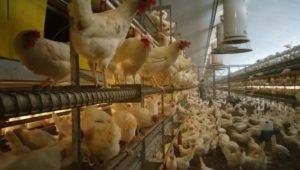Caged vs Cage Free Egg Laying Systems
 The two common types housing used in the egg laying industry are Caged and Cage Free. Up until recently, the most common style in the United States has been the caged system. This system was efficient and a proven method to produced table eggs, but because of public perception there is a move in the industry towards the cage free system.
The two common types housing used in the egg laying industry are Caged and Cage Free. Up until recently, the most common style in the United States has been the caged system. This system was efficient and a proven method to produced table eggs, but because of public perception there is a move in the industry towards the cage free system.
Many food retailers across North America, Europe, and even Asia have pledged to source 100% of their eggs from cage free facilities in the next 5 to 10 years. This has created uncertainty for the egg market and among egg producers about how to successfully manage laying hens in cage free systems while maintaining profitability. Further complicating matters is the fact that the definition of “cage free” is somewhat unclear and differs depending on the country and regulatory or verification agency. This has left producers uncertain on how to switch to cage free housing, the system to switch to, and how to manage birds under these systems. In the US, some states have already passed laws stating the aviary systems are the only way to raise egg producing hens.
Caged hens are confined in cages, on average each hen has 67 square inches of cage space. That isn’t much space, and leaves the hen unable to perform many natural behaviors such as, spreading it wings, nesting, perching, and dustbathing. However, manure management is much easier in the caged system as the manure drops through the cage floor onto a manure belt, which discharges the manure out the end of the barn. The hens are not able to walk through the manure, resulting in fewer health problems. Additionally, because the eggs do not come into contact with the manure, there are fewer instances of salmonella-contaminated eggs, making them safer for consumers.
Cage free hens have 1 square foot of space and can walk, spread their wings, lay eggs in a nest, perch, and dustbathe. Hens can perform more of their natural behaviors. However, manure management is much more difficult in the cage free barn. These systems also have manure belts under the cage floor that can be turned on to discharge out the back of the barn, but with free access to the barn floor, there is more manure in the birds living space. Because the birds can walk through the manure, disease are more common. There are also often fewer clean eggs, as birds often choose to lay their eggs on the floor, rather than in the nest.
Those are a few differences and set backs with the transition of the industry to cage free laying hens.
The difference between cage eggs and cage free eggs are the following:
• Cage free eggs cost more than caged eggs because cage free hens are more active than caged hens. Because cage free hens can roam and engage in their natural behaviors, they use more energy, and thus eat more feed than caged hens.
• There is no difference in nutrition between cage-free and caged eggs.
 The grading service is the same for both cage or cage free eggs, which provides for a standardized means of describing the marketability of the egg. Through the application of uniform grade standards, eggs can be classified according to a range of quality characteristics. USDA quality grade standards for eggs define and measure quality in terms of the appearance and condition of the shell as well as the interior quality of the yolk and albumen (white). The final quality rating (U.S. Grade AA, A, or B) is based on the factor with the lowest rating.
The grading service is the same for both cage or cage free eggs, which provides for a standardized means of describing the marketability of the egg. Through the application of uniform grade standards, eggs can be classified according to a range of quality characteristics. USDA quality grade standards for eggs define and measure quality in terms of the appearance and condition of the shell as well as the interior quality of the yolk and albumen (white). The final quality rating (U.S. Grade AA, A, or B) is based on the factor with the lowest rating.
Egg color does not affect the quality of the egg and is not a factor in the USDA quality grade standards for eggs. Eggs are sorted for color and marketed as either “white” or “brown” eggs.
On average, brown eggs are bigger in size than white eggs, due to the breed of chicken laying the eggs. Brown eggs cost more to produce and is usually reflected in the cost per dozen at retail.
This is a lot of information to digest, but the bottom line is when you go to purchase a dozen eggs in the supermarket, it will come down to your preferences for which type and size of egg you will purchase. There is no right or wrong answer.
Randy Rome
Application Engineer
Subscribe to our blog!
